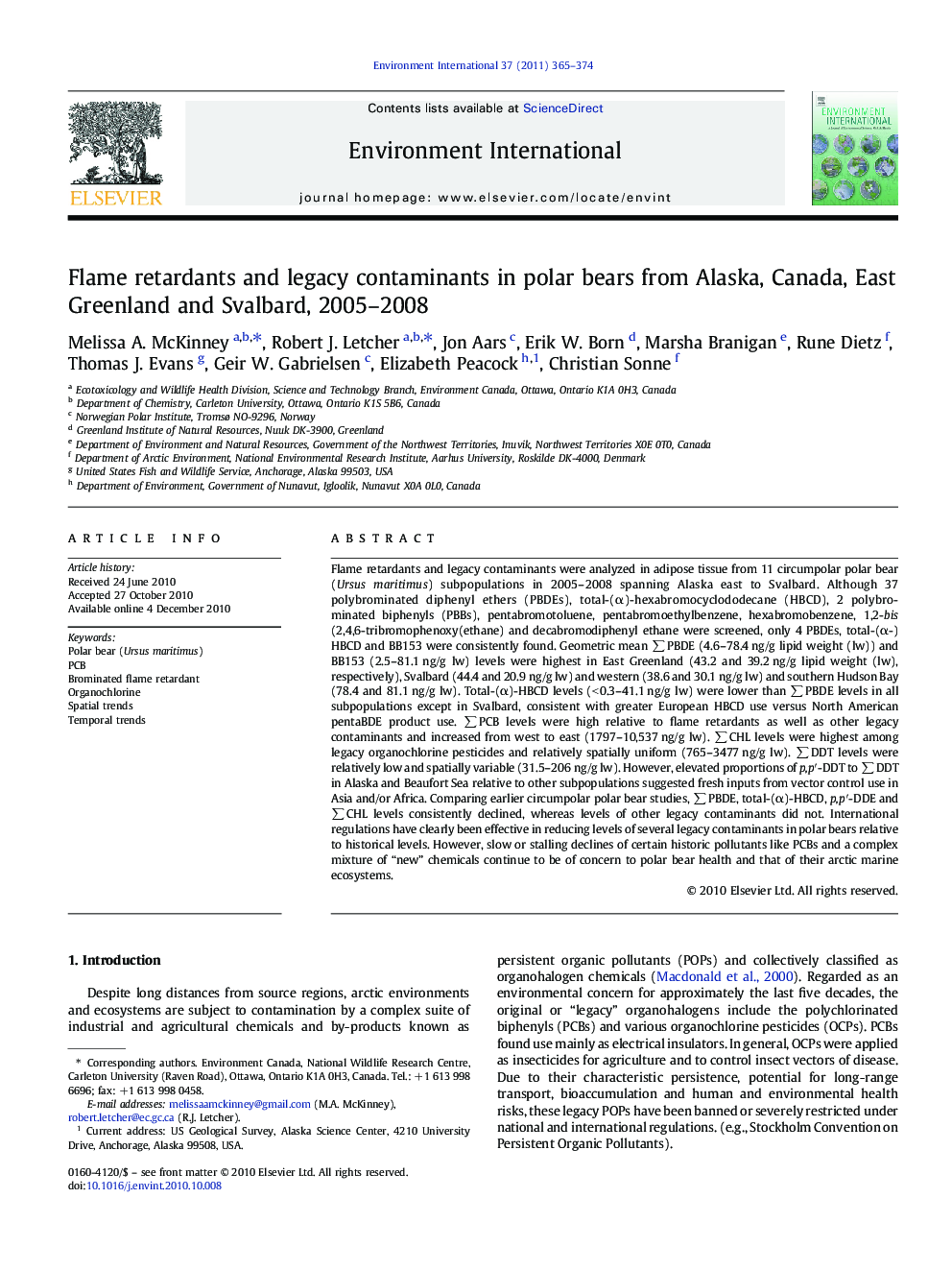| کد مقاله | کد نشریه | سال انتشار | مقاله انگلیسی | نسخه تمام متن |
|---|---|---|---|---|
| 4423229 | 1308816 | 2011 | 10 صفحه PDF | دانلود رایگان |

Flame retardants and legacy contaminants were analyzed in adipose tissue from 11 circumpolar polar bear (Ursus maritimus) subpopulations in 2005–2008 spanning Alaska east to Svalbard. Although 37 polybrominated diphenyl ethers (PBDEs), total-(α)-hexabromocyclododecane (HBCD), 2 polybrominated biphenyls (PBBs), pentabromotoluene, pentabromoethylbenzene, hexabromobenzene, 1,2-bis(2,4,6-tribromophenoxy(ethane) and decabromodiphenyl ethane were screened, only 4 PBDEs, total-(α-)HBCD and BB153 were consistently found. Geometric mean ∑ PBDE (4.6–78.4 ng/g lipid weight (lw)) and BB153 (2.5–81.1 ng/g lw) levels were highest in East Greenland (43.2 and 39.2 ng/g lipid weight (lw), respectively), Svalbard (44.4 and 20.9 ng/g lw) and western (38.6 and 30.1 ng/g lw) and southern Hudson Bay (78.4 and 81.1 ng/g lw). Total-(α)-HBCD levels (< 0.3–41.1 ng/g lw) were lower than ∑ PBDE levels in all subpopulations except in Svalbard, consistent with greater European HBCD use versus North American pentaBDE product use. ∑ PCB levels were high relative to flame retardants as well as other legacy contaminants and increased from west to east (1797–10,537 ng/g lw). ∑ CHL levels were highest among legacy organochlorine pesticides and relatively spatially uniform (765–3477 ng/g lw). ∑ DDT levels were relatively low and spatially variable (31.5–206 ng/g lw). However, elevated proportions of p,p′-DDT to ∑ DDT in Alaska and Beaufort Sea relative to other subpopulations suggested fresh inputs from vector control use in Asia and/or Africa. Comparing earlier circumpolar polar bear studies, ∑ PBDE, total-(α)-HBCD, p,p′-DDE and ∑ CHL levels consistently declined, whereas levels of other legacy contaminants did not. International regulations have clearly been effective in reducing levels of several legacy contaminants in polar bears relative to historical levels. However, slow or stalling declines of certain historic pollutants like PCBs and a complex mixture of “new” chemicals continue to be of concern to polar bear health and that of their arctic marine ecosystems.
Research Highlights
► PBDEs, HBCD, BB153 consistently found among BFRs screened in polar bears.
► Levels of legacy contaminants, ∑ PCB and ∑ CHL, high relative to BFRs.
► Contaminant levels generally highest in East Greenland, Svalbard, Hudson Bay bears.
► Declining temporal patterns for ∑ PBDE, total-(α)-HBCD, p,p′-DDE and ∑ CHL.
Journal: Environment International - Volume 37, Issue 2, February 2011, Pages 365–374